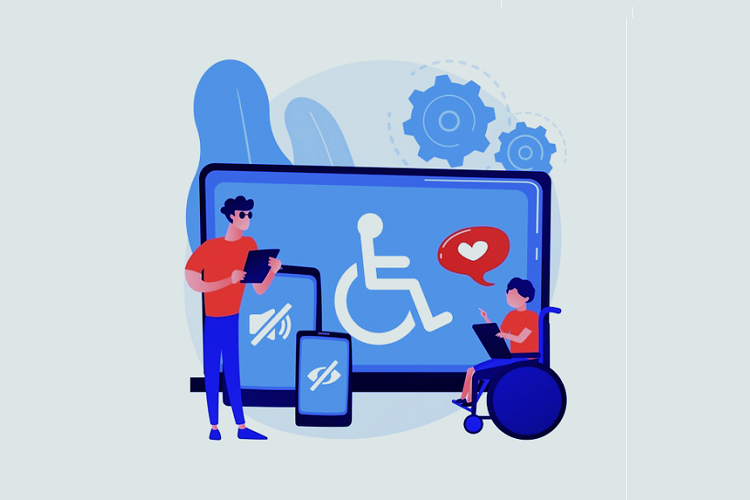Inclusive Design as a Business Strategy is reshaping digital leadership in 2025. Learn how accessibility fuels growth, ESG performance, innovation, brand trust, SEO, and competitive advantage.

Inclusive Design as a Business Strategy: A Powerful Guide to Accessibility-Driven Digital Leadership in 2025
Introduction: The New Standard of Digital Leadership
Inclusive Design as a Business Strategy is becoming the new benchmark for digital leadership in 2025. Today, successful digital transformation is no longer defined by innovation alone — it is defined by inclusion.
As AI-driven ecosystems reshape digital products, accessibility has emerged as a strategic advantage rather than a compliance checkbox. Leading brands like Apple, Microsoft, Shopify, and Adobe demonstrate that inclusive design strengthens trust, boosts growth, and enhances long-term digital credibility.
Accessibility isn’t just about WCAG compliance — it’s about designing technology for everyone and building sustainable, future-proof digital experiences.
-
Introduction: The New Standard of Digital Leadership
-
The Evolution of Accessibility: From Compliance to Competitive Edge
-
Accessibility as an ESG Differentiator
-
3.1 Accessibility and Brand Reputation
-
3.2 Accessibility and ESG Scoring
-
-
Inclusive Innovation: The New KPI for Digital Enterprises
-
4.1 AI and Inclusive UX
-
4.2 Design Thinking and Inclusion
-
-
Leadership Insights: How Accessibility-Driven Companies Set the Benchmark
-
Accessibility Roadmaps for Enterprise Web Modernization
-
The Business Impact: Accessibility as a Profit Multiplier
-
The Ethical Imperative of Inclusive Technology
-
Future Outlook: Accessibility in the Age of AI and Automation
-
Conclusion: Accessibility as the Hallmark of Digital Leadership
-
External Resources
-
Internal Links
In 2025, digital leadership is no longer measured by innovation alone — it is defined by inclusion. As businesses accelerate transformation and AI-driven technologies redefine user experiences, web accessibility has evolved from a compliance necessity to a strategic business advantage.
Today, the world’s most respected digital brands — from Apple and Microsoft to Shopify and Adobe — are proving that accessibility isn’t just about adhering to the Web Content Accessibility Guidelines (WCAG); it’s about creating products that work for everyone while driving growth, reputation, and trust.
Inclusive design has become a core metric of digital maturity. It sits at the intersection of ethics and economics, reflecting a company’s ability to innovate responsibly while ensuring no user is left behind. In an era where digital equity is as important as digital efficiency, accessibility has become the language of leadership.
The Evolution of Accessibility: From Compliance to Competitive Edge
For years, accessibility was seen as a checkbox — a regulatory obligation to avoid lawsuits or public backlash. But as digital experiences became the primary medium for engagement, companies began to realize something powerful: inclusive design drives innovation.
When websites and applications are built to accommodate diverse needs — whether through adaptable text, voice navigation, color contrast, or screen reader compatibility — they naturally become more usable, intuitive, and scalable. Accessibility makes technology simpler, faster, and smarter for everyone, not just for users with disabilities.
The shift is clear:
- 2010s: Accessibility meant WCAG compliance.
- 2020s: Accessibility means competitive advantage.
Now, businesses that embed accessibility into their design systems, development frameworks, and AI models are building future-proof ecosystems — not just products.
Accessibility as an ESG Differentiator
Environmental, Social, and Governance (ESG) criteria have become the benchmark of responsible business. Within this framework, accessibility stands as a core pillar of “Social” responsibility — demonstrating a company’s commitment to inclusivity and ethical technology.
Accessibility reflects a brand’s willingness to create equal digital opportunities — not just for compliance, but as a human-centered mission. In boardrooms and sustainability reports, accessibility now sits alongside carbon reduction and diversity as a visible indicator of corporate integrity.
1. Accessibility and Brand Reputation
Consumers are more socially conscious than ever. A brand that prioritizes accessibility signals empathy, foresight, and inclusiveness — qualities that resonate deeply in an age of purpose-driven consumption.
Companies that ignore accessibility risk more than legal consequences; they risk eroding trust. In contrast, those that lead inclusively earn loyalty, advocacy, and investor confidence.
2. Accessibility and ESG Scoring
Investors increasingly analyze how digital ecosystems align with ESG values. Accessibility initiatives — such as inclusive hiring, accessible digital assets, and transparent compliance reporting — directly impact ESG performance metrics.
This means that building accessible web platforms isn’t just an ethical move — it’s a financially sound strategy that influences capital, partnerships, and market positioning.
Inclusive Innovation: The New KPI for Digital Enterprises
Digital success is no longer defined by speed-to-market or feature innovation alone. The new key performance indicator (KPI) for enterprises is inclusive innovation — how effectively an organization merges technology with empathy.
Inclusive innovation means designing solutions that serve all demographics, geographies, and abilities. It transforms accessibility into a strategic growth engine, unlocking new markets and audience segments.
AI and Inclusive UX
AI and machine learning have become instrumental in scaling accessibility. Modern systems use AI-driven analytics to identify barriers, recommend fixes, and even automate compliance testing.
Examples include:
- AI-generated alt text for images to support screen readers.
- Voice navigation and natural language interfaces for users with mobility or visual impairments.
- Predictive personalization that adapts layouts and interactions based on user preferences.
By merging accessibility with AI, developers are creating adaptive user experiences — websites that learn and evolve with users’ needs.
Design Thinking and Inclusion
Design thinking — once focused purely on innovation — is now being redefined through inclusivity. Leading organizations are using accessibility-first prototypes, diverse user testing, and empathy mapping to ensure every interface considers cognitive, sensory, and physical diversity.
Inclusive design is not about creating for the “average” user; it’s about removing barriers for all. This mindset drives more comprehensive research, cleaner code, and more sustainable digital ecosystems.
Leadership Insights: How Accessibility-Driven Organizations Set the Benchmark

Companies that embrace accessibility as a strategic priority are not only improving usability — they are defining digital leadership standards.
1. Apple: Accessibility as Core Design DNA
Apple’s philosophy — “Technology is most powerful when it empowers everyone” — is more than a slogan. It’s embedded in every device, from VoiceOver on iOS to Live Captions on macOS. Apple’s inclusive design is both a moral choice and a brand differentiator, reflecting its long-term innovation philosophy.
2. Microsoft: Accessibility as a Growth Culture
Microsoft’s “Inclusive Design Toolkit” has redefined how software teams think. The company treats accessibility as an innovation framework, not a constraint. The result? Products that empower millions and a brand synonymous with inclusive technology.
3. Adobe and Shopify: Accessibility as a Design Standard
Adobe’s accessibility-first approach in Creative Cloud and Shopify’s accessible theme architecture are prime examples of how accessibility drives product quality. Both companies have embedded accessibility testing into every product iteration, reducing rework and strengthening customer trust.
These organizations prove that accessibility maturity aligns directly with digital excellence — and that leadership in technology today requires leadership in inclusivity.
Accessibility Roadmaps for Enterprise Web Modernization
For organizations undergoing digital transformation, accessibility should be a strategic pillar, not an afterthought. An accessibility roadmap integrates inclusive practices across every stage of web modernization — from design to deployment.
Step 1: Audit and Assess
Begin with a comprehensive accessibility audit to evaluate your current ecosystem. Use automated tools (axe DevTools, WAVE, Lighthouse) and manual testing to uncover issues across pages, components, and workflows.
Establish a baseline aligned with WCAG 2.2 or 3.0 standards, then categorize findings by severity and user impact.
Step 2: Build an Accessibility Framework
Develop a cross-functional accessibility framework that aligns design, development, and content teams. Integrate accessibility checkpoints into your design system, code repositories, and QA pipelines.
Step 3: Integrate Accessibility into DevOps
Shift accessibility left. Embed accessibility testing into CI/CD pipelines, enabling automated scans during every release. This ensures continuous compliance and minimizes post-launch defects.
Step 4: Empower Through Training
Invest in accessibility education for designers, developers, and QA specialists. Accessibility isn’t a one-time implementation — it’s a cultural practice that evolves with technology.
Step 5: Measure and Report
Define measurable KPIs such as:
- Accessibility score improvement (via audits)
- Compliance level (A, AA, AAA)
- Reduced accessibility-related complaints
- Positive user feedback from diverse audiences
Regularly publish accessibility statements and progress updates to demonstrate transparency and accountability.
Step 6: Innovate Continuously
Accessibility is not static. Emerging technologies — like AR/VR, spatial interfaces, and generative AI — require new accessibility paradigms. Proactive enterprises continuously iterate to ensure inclusivity keeps pace with innovation.
The Business Impact: Accessibility as a Profit Multiplier
Accessibility doesn’t just make websites compliant — it makes them perform better.
- Higher engagement: Accessible websites improve usability for everyone, leading to longer session times and lower bounce rates.
- SEO benefits: Accessibility enhancements (semantic structure, alt text, headings) align directly with Google’s ranking algorithms.
- Market expansion: Over 1 billion people globally live with disabilities. Inclusive digital experiences unlock massive untapped markets.
- Brand loyalty: Accessibility demonstrates empathy and social responsibility — key factors in customer retention and advocacy.
- Reduced costs: Building accessibly from the start reduces costly retrofits and improves design consistency.
Accessibility isn’t a trade-off. It’s a growth multiplier — improving efficiency, customer reach, and digital credibility all at once.
The Ethical Imperative of Inclusive Technology

Technology shapes society — and society demands inclusivity. As digital ecosystems become the foundation of education, commerce, and communication, the responsibility to design for universal access is undeniable.
Accessibility is no longer a feature. It’s a moral obligation — one that defines the integrity of modern innovation.
When leaders prioritize accessibility, they send a message: our technology is for everyone. This message doesn’t just elevate brand image; it builds trust, the most valuable currency in a digital economy.
Future Outlook: Accessibility in the Age of AI and Automation
The next chapter of accessibility lies in AI-driven automation and predictive inclusion.
Imagine systems that can:
- Automatically detect and fix accessibility issues in real time.
- Personalize layouts based on user abilities and preferences.
- Use AI-powered voice interfaces to enhance accessibility across devices.
In the near future, AI will not only assist developers — it will become the architect of accessible systems. The convergence of AI, design thinking, and accessibility principles will define the next era of intelligent, human-centered technology.
Conclusion: Accessibility as the Hallmark of Digital Leadership
In 2025 and beyond, accessibility is more than a technical standard — it is a strategic philosophy. Organizations that integrate inclusivity into their digital DNA are not just following best practices; they are leading a global shift toward ethical innovation.
Inclusive design has evolved into a boardroom priority — influencing brand equity, ESG rankings, and market performance. It defines who leads, who follows, and who gets left behind in the digital revolution.
Accessibility is not the cost of doing business; it is the currency of sustainable digital leadership.
Those who design for everyone today will define the future of technology tomorrow.


